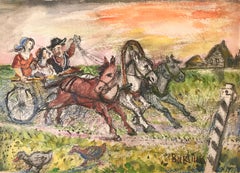David Burliuk for sale on 1stDibs
Considered the "Father of Russian Futurism" and one of the leading figures of the Modernist avant-garde, David Burliuk is experiencing an enormous resurgence of interest and critical attention forty years after his death.
As painter, poet and writer of manifestos, Burliuk was a central figure in the intellectual and artistic avant-garde of early 20th century Russia. He was inspired by revolutionary Western European art movements ranging from Impressionism and Post-Impressionism to Fauvism, Cubism, German Expressionism, Italian Futurism and Symbolism, but also by the Orthodox religious icons and naive folk art of Russia and his birthplace, the Ukraine. Art movements to which he contributed include Russian Neo-Primitivism, an infusion of Fauvist color and Expressionist brushwork into landscapes and portraits inspired by folk art; Rayonism, a synthesis of Cubist configurations of space and Futurist representations of speed and dynamism; and Cubo-Futurism, a blend of Neo-Primitivist subjects and Cubist or Futurist style.
Burliuk participated in the foundational exhibition of Moscow's influential "Jack of Diamonds" group in 1910 and also in its subsequent shows, together with not only Russian artists - Chagall, Kandinsky, and Malevich among others - but also foreign celebrities including Picasso, Matisse, Braque and Derain. He also exhibited in Munich in 1911 with the international Der Blaue Reiter group that included Kandinsky, Jawlensky, Franz Marc and Paul Klee, and contributed an essay to the first volume of the Blaue Reiter group's Almanac.
Born in the Ukriane in 1882, he enjoyed access to a high degree of education, with periods of study in Kazan, Odessa, Munich, Paris, and Moscow. His participation in the avant-garde spirit of the times led to his expulsion from the Moscow School of Painting, Sculpture and Architecture in 1914. Burliuk fled Russia in 1918 during the Bolshevik revolution and spent the next four years in Siberia and then Japan. He was court painter to the Japanese emperor from 1920-1922 and very well received there. However, anticipating war with Russia, the Japanese government requested that he leave.
He then immigrated to New York and developed his "Radio" style, a dynamic and innovative blend of Symbolism, Neo-Primitivism and Expressionism, so called in reference to the advent of radio and its ability to make available a variety of cultures. Burliuk's critical acceptance in the New World came in 1923 with a major exhibition of his paintings at the Brooklyn Museum and soon thereafter a solo show at the Société Anonyme - the first museum of experimental modern art - established in New York by Marcel Duchamp, Man Ray and Katherine Dreier.
In 1939, after experiencing increasing success as a writer, editor and painter, he moved his family from the Lower East Side to Hampton Bays, Long Island. He traveled again to Europe which prompted a series of pictures inspired by Van Gogh and Pieter Brueghel the Younger. In addition to Cubo-Futurist and Symbolist paintings, he continued creating proto-naive paintings, depicting the American landscape as well as the Russian countryside.
Finding the Right drawings-watercolor-paintings for You
Revitalize your interiors — introduce drawings and watercolor paintings to your home to evoke emotions, stir conversation and show off your personality and elevated taste.
Drawing is often considered one of the world’s oldest art forms, with historians pointing to cave art as evidence. In fact, a cave in South Africa, home to Stone Age–era artists, houses artwork that is believed to be around 73,000 years old. It has indeed been argued that cave walls were the canvases for early watercolorists as well as for landscape painters in general, who endeavor to depict and elevate natural scenery through their works of art.
The supplies and methods used by artists and illustrators to create drawings and paintings have evolved over the years, and so too have the intentions. Artists can use their drawing and painting talents to observe and capture a moment, to explore or communicate ideas and convey or evoke emotion. No matter if an artist is working in charcoal or in watercolor and has chosen to portray the marvels of the pure human form, to create realistic depictions of animals in their natural habitats or perhaps to forge a new path that references the long history of abstract visual art, adding a drawing or watercolor painting to your living room or dining room that speaks to you will in turn speak to your guests and conjure stimulating energy in your space.
When you introduce a new piece of art into a common area of your home — a figurative painting by Italian watercolorist Mino Maccari or a colorful still life, such as a detailed botanical work by Deborah Eddy — you’re bringing in textures that can add visual weight to your interior design. You’ll also be creating a much-needed focal point that can instantly guide an eye toward a designated space, particularly in a room that sees a lot of foot traffic.
When you’re shopping for new visual art, whether it’s for your apartment or weekend house, remember to choose something that resonates. It doesn’t always need to make you happy, but you should at least enjoy its energy. On 1stDibs, browse a wide-ranging collection of drawings and watercolor paintings and find out how to arrange wall art when you’re ready to hang your new works.

